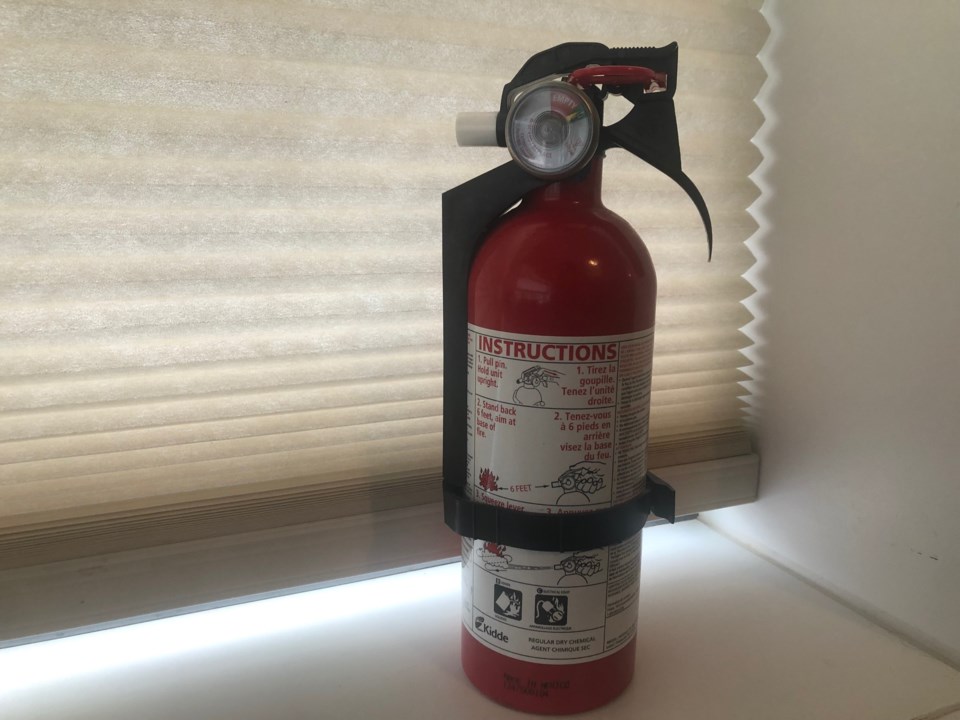A home fire extinguisher can be a lifesaver.
Collingwood Fire Prevention Officer Carl Prochilo would like to remind residents to make sure they have a fire extinguisher in their home in case of an emergency. He offers the following tips on what kind to get, where to keep it, and how to use it.
Placed near an exit, in an easy-to-grab spot (not at the back, under the kitchen sink), it can put out a small fire before the
firefighters arrive, or at least suppress the flames while you escape.
Size of Extinguisher
The main distinction among home extinguishers is size. In most cases bigger is better, but sometimes the biggest extinguishers are too heavy to manoeuvre. (The weight on an extinguisher refers to the amount of chemical inside; the canister
adds several more pounds.)
There is also a difference between rechargeable extinguishers, with metal valves, and disposable ones, which have plastic valves. A
rechargeable one will cost more, but refilling it once the pressure gauge shows that use or time has depleted the contents may be less expensive than buying a new disposable one.
The average weight of a home fire extinguisher is between 1.5 to 3 kilograms.
Classes of Fires and Ratings
Every household extinguisher is labelled A, B, or C, which tells you the types of fires the extinguisher is effective against.
- A is ordinary combustibles like wood, paper, and cloth,
- B is flammable liquids, such as gasoline or cooking oil, and
- C is live electricity.
In the fine print on the label, these letters are preceded by numbers — for example, 3-A: 40-B:C — which are the extinguisher's classification rating. The numbers, assigned by underwriters laboratories, tell the extinguisher's relative effectiveness against each type of fire, regardless of its weight or the chemical it uses.
The higher the number, the greater the effectiveness. So an extinguisher with a 4-A rating is more effective on ordinary combustibles than a 2-A one.
The C designation carries no number; it just means the extinguisher's chemicals won't conduct electricity.
The average rating for a home fire extinguisher is 2-A:10-B:C.
All household extinguishers are classified A, B, or C (or a combination of these) on the label to indicate which types of fires – ordinary combustibles, flammable liquids, or electrical – you can use them on. Many of the ones sold at home stores are classified A:B:C Multi-purpose dry chemical and fight all three types of fires.
When to use fire extinguishers
It’s important to remember that fire extinguishers are only one element of a complete fire response plan.
Only use your extinguisher after making sure:
- All residents of the home have been evacuated to safety
- The fire department has been notified
- There is a clear exit behind the person using the extinguisher
Use your extinguisher only to keep a small self-contained fire from growing, only when the room is not filled with smoke, or to create a safe pathway out of the home.
Be sure to read the instructions and become familiar with your fire extinguisher's parts and operation before a fire breaks out.
How to use fire extinguishers
Stand 6 feet away from the fire and follow the four-step PASS procedure recommended by the National Fire Protection Association:
- P - Pull the pin and hold the extinguisher with the nozzle pointing away from you.
- A - Aim low at the base of the fire.
- S - Squeeze the lever slowly and evenly to discharge the extinguishing agent. (When
- the agent first hits the fire, the fire may briefly flare up. This should be expected.
- S - Sweep the nozzle from side to side, moving carefully toward the fire. Keep the
- extinguisher aimed at the base of the fire.
Remember to test the fire extinguisher before approaching the fire.
Keep low and approach with the wind at your back, Back away, watch for the fire rekindling.
Depending on the size of your extinguisher, continuous use can last, on average, 15-20 seconds.
Whenever you have used an extinguisher, whether or not it is completely empty, you should replace it or refill it as soon as possible. Should the pressure gauge fall below the green into the red, have it serviced.
Extinguishers with plastic valves are not refillable and should be discarded after use.
Have the fire department inspect the fire site, even if you’re sure you’ve extinguished the fire. If you are unsure about using a fire extinguisher, get everyone out of the house quickly and call 911 from a safe location.
Remember, your safety and the safety of your family is important! Get out, stay out and call 911. Know when to go.
Fire extinguishers are one element of a fire response plan, but the primary element is a safe escape.
Every household should have a home fire escape plan and working smoke/CO alarms.
For more information, or if you have any questions, please contact the Collingwood Fire Dept at 705-445-3920.



